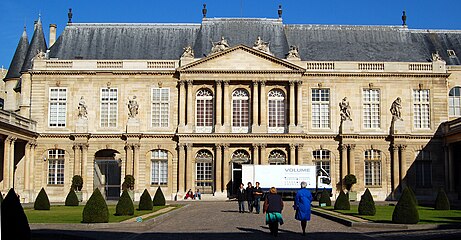| Length | 705 m (2,313 ft) |
|---|---|
| Width | 8 to 13 m (26 to 43 ft) |
| Arrondissement | 3rd, 4th |
| Quarter | Marais |
| Coordinates | 48°51′25.56″N 2°21′43.98″E / 48.8571000°N 2.3622167°E |
| From | 19 Place des Vosges |
| To | 56 Rue des Archives |
| Construction | |
| Completion | 1868 |
| Denomination | 1500 |
Rue des Francs-Bourgeois (pronounced [ʁy de fʁɑ̃ buʁʒwa]) is one of the longer streets in the Marais district of Paris, France.[1]
Starting near Centre Georges Pompidou (rue Rambuteau), the road is considered trendy, with numerous fashion boutiques. Rue des Francs-Bourgeois is one of the few streets which largely ignores France's strong tradition of Sunday closure, even within Paris. As such, it is a popular location for weekend brunches and walks. Notable buildings include the ancient hôtels Carnavalet, Lamoignon, Sandreville, d'Albret, d'Alméras, Poussepin, de Coulanges, Hérouet, de Jaucourt, de Fontenay, de Breteuil and de Soubise. Hôtel Carnavalet houses the museum of the history of Paris.[citation needed]
History[edit]
The street was once known as the Rue des Poulies. In 1415, a noble called le Mazurier offered the Chief Prior of France a huge private mansion with 24 bedrooms to receive 48 poor people. These people were so poor that they didn't pay the taxes of the city, and were called francs-bourgeois. In 1868, the street was joined with Rue Neuve Saint-Catherine and Rue du Paradis au Marais.[citation needed]
Jack Kerouac facetiously translated the name as "street of the outspoken middle class."[2]
-
Hôtel de Soubise au 60
-
Maison de Jean Herouet au 54
-
IONIS Education Group au 28
-
Entrée de l'Hôtel d'Almeras au 30
-
Entrée de l'Hôtel d'Albret au 31
-
Hôtel de Coulanges au 37
-
Entrée de l'Hôtel de Coulanges
-
La rue des Francs-Bourgeois, direction la Place des Vosges.
References[edit]
- ^ "Rue des Francs-Bourgeois". ParisMarais: The Art of Living Guide. Retrieved 18 October 2020.
- ^ Melehy, Hassan (2016). Kerouac: Language, Poetics, and Territory. New York: Bloomsbury. p. 159. ISBN 978-1-5013-1436-0. Retrieved 29 December 2023.
External links[edit]
 Media related to Rue des Francs-Bourgeois (Paris) at Wikimedia Commons
Media related to Rue des Francs-Bourgeois (Paris) at Wikimedia Commons









Well, that’s interesting to know that Psilotum nudum are known as whisk ferns. Psilotum nudum is the commoner species of the two. While the P. flaccidum is a rare species and is found in the tropical islands. Both the species are usually epiphytic in habit and grow upon tree ferns. These species may also be terrestrial and grow in humus or in the crevices of the rocks.
View the detailed Guide of Psilotum nudum: Detailed Study Of Psilotum Nudum (Whisk Fern), Classification, Anatomy, Reproduction